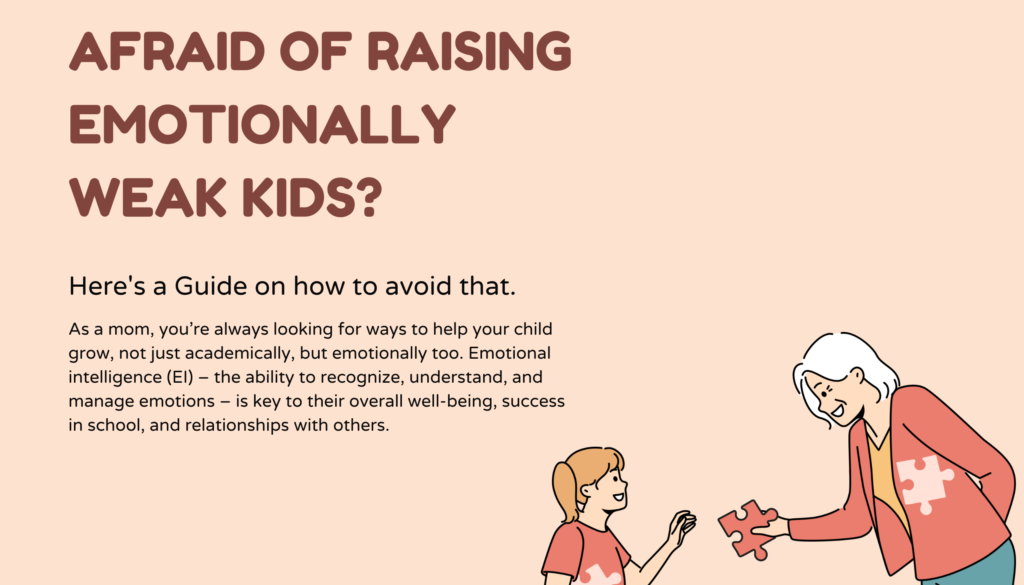Afraid of Raising Emotionally Weak Kids? Here’s a Guide on how to avoid that.
As a mom, you’re always looking for ways to help your child grow, not just academically, but emotionally too. Emotional intelligence (EI) – the ability to recognize, understand, and manage emotions – is key to their overall well-being, success in school, and relationships with others. The good news is that teaching emotional intelligence doesn’t require a classroom or structured lesson plan. In fact, some of the best lessons can be taught through everyday moments with your child.
Here are some simple, practical ways to incorporate emotional intelligence into your daily life:
1. Help Them Recognize and Name Their Emotions
Kids are often still learning how to identify what they’re feeling. By naming emotions in the moment, you help them better understand their own reactions.
- Example: If your child is acting out after school, take a moment to ask, “I see you’re upset, are you feeling frustrated, sad, or mad?” You can also say things like, “I feel frustrated when I can’t find my keys.” This not only expands their emotional vocabulary but also shows that all feelings are okay.
- Why It Works: The more kids understand and can name their emotions, the better equipped they are to manage them. And the earlier they start, the easier it becomes over time.
2. Model How to Manage Emotions
Children learn best by watching the adults around them. When they see you calmly managing your own emotions, they’ll be more likely to try the same.
- Example: If something doesn’t go as planned (say, you’re running late or you spill coffee), instead of reacting with frustration, you could say, “Oh no! That didn’t go as I expected. I’m going to take a deep breath and fix this.” Then, show them what you’re doing to calm down, like taking deep breaths or counting to ten.
- Why It Works: Your kids will see that it’s normal to feel upset, but it’s important to pause, breathe, and regroup. This gives them a healthy model for emotional regulation.
3. Practice Empathy in Conversations
Empathy is an important part of emotional intelligence. You can nurture this by showing interest in how your child is feeling and helping them connect to others’ emotions.
- Example: If your child has a problem with a friend at school, instead of jumping to conclusions, you could ask, “How do you think your friend feels?” or “What do you think you could do to make the situation better?”
- Why It Works: By teaching empathy, you’re helping your child understand that other people have feelings, too, and that their actions can affect others. This strengthens their ability to form healthy, respectful relationships.
4. Celebrate Effort, Not Just Outcomes
Teaching your child to be proud of their efforts, regardless of the result, builds their self-esteem and a growth mindset.
- Example: After your child finishes a challenging puzzle or takes on a new task, acknowledge their effort: “I saw how hard you worked on that puzzle! You didn’t give up even when it was tricky.”
- Why It Works: When kids are praised for trying hard rather than just for succeeding, they learn to focus on their own growth and resilience, rather than just outcomes. This helps them handle setbacks better in the future.
5. Turn Conflicts into Teaching Moments
Disagreements and conflicts are a natural part of life, but how you respond can teach your child valuable lessons in emotional intelligence.
- Example: If your kids are arguing over a toy, instead of immediately stepping in to resolve it, you could guide them with, “What’s going on? How can we solve this so everyone feels happy?” Then, help them negotiate and take turns.
- Why It Works: By stepping back and allowing your child to solve their own problems (with your guidance), they learn conflict resolution skills and how to manage strong emotions in a healthy way.
6. Use Positive Self-Talk to Build Resilience
Self-talk is the way we talk to ourselves, and it plays a huge role in emotional intelligence. Teaching your child how to talk kindly to themselves builds confidence and resilience.
- Example: If your child doesn’t do well on a test or has a tough time with something, model positive self-talk by saying, “I didn’t do well this time, but I can learn from it and do better next time.” Encourage your child to say similar things, like, “I didn’t get it right, but I’m learning.”
- Why It Works: Positive self-talk helps children manage disappointment and bounce back from setbacks. It also teaches them that failure isn’t something to be afraid of – it’s a part of learning.
7. Encourage Time for Reflection
Taking a moment each day to reflect on emotions is a great way to reinforce emotional intelligence.
- Example: Before bed, ask your child, “What made you feel happy today? Was there anything that made you upset?” This can lead to a meaningful conversation where you can explore their feelings and how to handle them next time.
- Why It Works: Reflection helps children process their emotions and learn from their experiences. It also gives you a chance to offer guidance and perspective.
Conclusion
As a mom, you play a pivotal role in teaching your child emotional intelligence. And the best part? You don’t need special tools or extra time. By recognizing and responding to emotions in everyday moments, you’re already helping your child develop skills that will last a lifetime. Remember, emotional intelligence is learned through practice, and with your gentle guidance, your child will grow into a confident, empathetic, and emotionally healthy individual.



